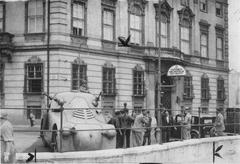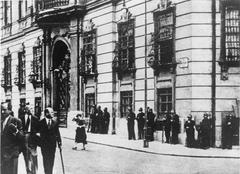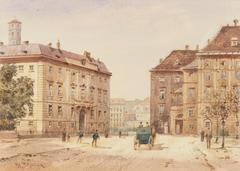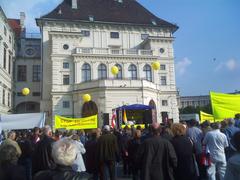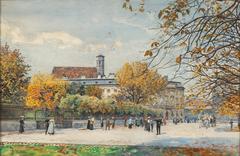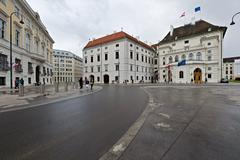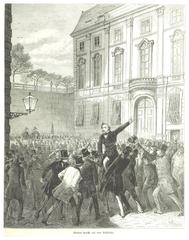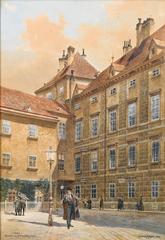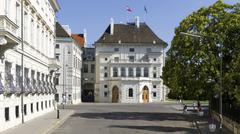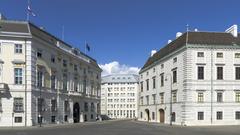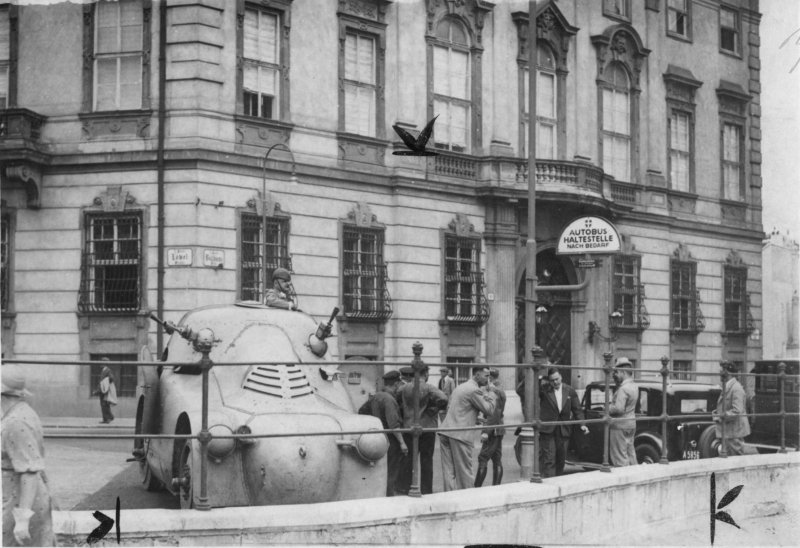
Ballhausplatz Vienna: Visiting Hours, Tickets, and Historical Significance Guide
Date: 15/06/2025
Introduction
Nestled in Vienna’s historic Innere Stadt district, Ballhausplatz is an iconic square that embodies Austria’s political legacy and architectural splendor. Once the site of an imperial ball house, it has evolved into the official seat of the Federal Chancellor and remains a pivotal symbol of Austrian statehood. The square and its surroundings reflect a layered history—from imperial grandeur and the Congress of Vienna to 20th-century memorials and modern democratic life.
This comprehensive guide covers everything you need to know about visiting Ballhausplatz: opening hours, ticketing, accessibility, guided tours, nearby attractions, and essential historical context. Whether you’re a history buff, architecture enthusiast, or casual traveler, Ballhausplatz offers an immersive experience in the heart of Vienna. For additional planning, consult official resources like the Vienna Tourist Information and scholarly accounts (Rumpler, 1981).
Table of Contents
- Introduction
- Ballhausplatz: Historical and Political Significance
- Architectural Heritage and Key Landmarks
- Visitor Information
- Nearby Attractions
- Practical Visitor Tips
- FAQs
- Visuals and Media Suggestions
- Conclusion
- References
Ballhausplatz: Historical and Political Significance
Ballhausplatz has long stood at the crossroads of Austrian decision-making. Named after the former “Ballhaus” where jeu de paume was played, it became the seat of foreign policy during the Habsburg monarchy (Rumpler, 1981). The Austro-Hungarian government and foreign ministry operated from here, making it a nerve center for imperial administration.
The Congress of Vienna (1814–1815), one of Europe’s most significant diplomatic gatherings, was hosted at Ballhausplatz, with Prince Metternich presiding over negotiations that shaped the continent’s future.
Today, Ballhausplatz houses the Federal Chancellery (Bundeskanzleramt), maintaining its role at the heart of Austrian governance. The square is also a focal point for political demonstrations and public gatherings, highlighting its continued relevance in democratic society (Kurier, 2024).
Architectural Heritage and Key Landmarks
Federal Chancellery (Bundeskanzleramt)
This Baroque palace, with its elegant symmetry and restrained decoration, dominates Ballhausplatz. Built in the early 18th century by Johann Lukas von Hildebrandt, its façade reflects both imperial authority and modern administrative function (Wien Geschichte Wiki).
Presidential Chancellery (Präsidentschaftskanzlei)
Located at the edge of the Hofburg, this building blends imperial and modern elements. Since 1946, it has served as the office of Austria’s head of state, exemplifying Vienna’s architectural continuity (Wien Geschichte Wiki).
Deserteursdenkmal (Deserters’ Memorial)
Unveiled in 2014, this minimalist monument honors those persecuted under Nazi military law. Three X-shaped pillars symbolize resistance and moral courage, offering a contemplative counterpoint to the Baroque surroundings (Wien Geschichte Wiki).
Visitor Information
Hours and Ticketing
- Square Access: Open 24/7; no ticket required.
- Building Access: The Federal Chancellery and Presidential Chancellery are generally not open to the public.
- Nearby Museums: For ticketed entry to nearby sites (e.g., Hofburg Palace, Spanish Riding School), purchase in advance via official websites (Wien.info).
Accessibility
- The square is flat and fully wheelchair accessible, with paved surfaces and curb cuts.
- Closest U-Bahn stations: Herrengasse (U3) and Stephansplatz (U1, U3).
- Bus and tram stops nearby at Ringstrasse and Michaelerplatz (Carly Hulls).
Guided Tours
- Guided walking tours often feature Ballhausplatz as part of Vienna’s imperial core, providing historical and architectural context.
- Specialized tours exploring political or wartime history are available via local operators (GuruWalk).
Events and Demonstrations
- Ballhausplatz frequently hosts political rallies and public events. These are typically peaceful but can affect access. Check local news or the Vienna Tourism Board for updates (Kurier, 2024).
Nearby Attractions
Ballhausplatz’s prime location makes it a gateway to top Viennese sites:
- Hofburg Palace: Imperial apartments, museums, and the Spanish Riding School.
- Volksgarten: Rose gardens and the neoclassical Theseus Temple.
- Austrian Parliament, Burgtheater, and Austrian National Library: All within walking distance (EuroTravelsByDesign).
Practical Visitor Tips
- Best Times to Visit: Spring and autumn offer pleasant weather and lighter crowds.
- Photography: Early morning or late afternoon provides the best light for capturing the Baroque façades and memorials.
- Dress and Etiquette: Smart-casual clothing is appropriate, especially when visiting neighboring museums or historic sites.
- Food and Drink: Cafés like Café Central and Demel are within a 10-minute walk, offering traditional Viennese refreshments.
- Accessibility: The area is stroller- and wheelchair-friendly, with accessible restrooms in adjacent complexes.
Frequently Asked Questions (FAQs)
Q: What are the visiting hours for Ballhausplatz?
A: The square is open 24/7 to the public.
Q: Is there an entry fee?
A: No, visiting Ballhausplatz is free of charge.
Q: Are guided tours available?
A: Yes, many walking tours include Ballhausplatz; booking in advance is recommended.
Q: Is Ballhausplatz accessible for visitors with mobility impairments?
A: Yes, the area is flat, paved, and accessible.
Q: How do I get there by public transport?
A: Use U-Bahn stations Herrengasse (U3) or Stephansplatz (U1, U3). Trams and buses stop nearby as well.
Q: Can I take photos or film?
A: Photography of the square and building exteriors is allowed; professional filming may require a permit.
Visuals and Media Suggestions
- Visit the official Vienna Tourism website for high-resolution images and interactive maps.
- Consider virtual tours or 360-degree panoramas to preview the square before your visit.
- Use alt text like “Ballhausplatz Vienna historical site” when searching for visuals.
Conclusion
Ballhausplatz is not only a focal point of Austria’s political history but also an architectural jewel set amid Vienna’s most celebrated landmarks. Its open access, central location, and rich historical tapestry make it an essential stop for any visitor. To enhance your experience, join a guided tour, explore neighboring attractions, and consult up-to-date resources. For personalized tips and event updates, download the Audiala app or visit the Vienna Tourist Board.
References and Further Reading
- Ballhausplatz Visiting Hours, Tickets, and History: A Guide to Vienna’s Historic Square, 2024, Audiala (https://www.audiala.com/ballhausplatz-visiting-hours-tickets-history)
- Ballhausplatz in Vienna: Visiting Hours, Tickets, History & Travel Tips, 2024, EuroTravelsByDesign (https://www.eurotravelsbydesign.com/post/the-famous-buildings-and-architecture-of-vienna)
- Ballhausplatz Visiting Hours, Tickets, and Architectural Highlights in Vienna, 2024, Wien Geschichte Wiki (https://www.geschichtewiki.wien.gv.at/Ballhausplatz)
- Visiting Ballhausplatz: Hours, Tickets, and Tips for Exploring Vienna’s Historic Square, 2024, Vienna Official Tourist Info (https://www.wien.info/en)
- Rumpler, H., 1981. The Role of Ballhausplatz in the Austro-Hungarian Empire, European Historical Review (https://www.persee.fr/doc/efr_0000-0000_1981_act_54_1_1436)
- Kurier, 2024. Large Demonstrations at Ballhausplatz, News Coverage (https://kurier.at/chronik/wien/grossdemo-wien-ballhausplatz-gegen-schwarzblau-fpoe-kickl-oevp-regierung/403006540)
- Carly Hulls, 2024. What to Know Before You Visit Vienna (https://carlyhulls.com/blog/what-to-know-before-you-visit-vienna)
- GuruWalk, Vienna Free Tour (https://www.guruwalk.com/walks/55482-free-tour-vienna-part-2-jewish-traces-and-hitler-s-vienna)
- ArchDaily, Vienna’s Architectural Evolution (https://www.archdaily.com/1010251/viennas-architectural-evolution-21-landmarks-spanning-baroque-secession-and-contemporary-styles)
